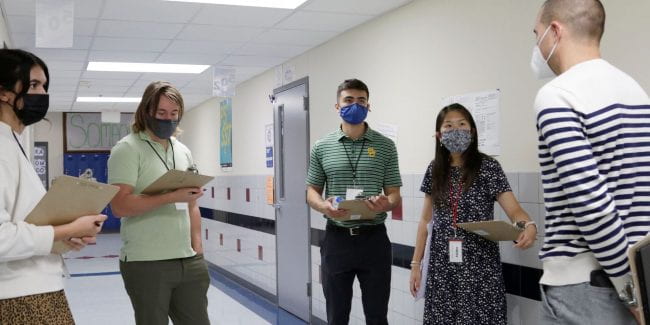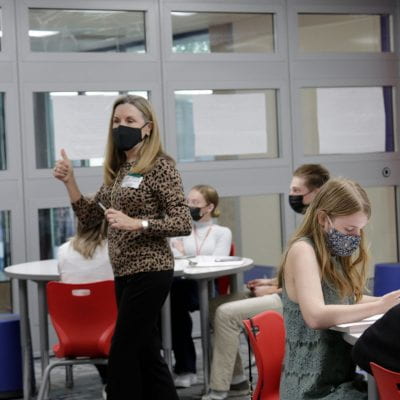
After each classroom session during “clinical rounds,” Dr. Neil Shanks (right) and secondary education students paused for in a brief review before heading to the next class for observations.
Secondary teacher-education majors in the Baylor School of Education’s (SOE) undergraduate program enjoyed a new field experience on Professional Development School (PDS) campuses this fall. It was the first semester that students went through the full immersion into a new course component, “instructional rounds,” on school campuses.
Dr. Madelon McCall, clinical associate professor and coordinator of the secondary education program, said the SOE’s program is modeled on clinical rounds for medical students.
“It is similar to medical rounds in that students learn about the content, go observe it in practice, and then come back together and spend time debriefing with their professor,” McCall said. “Our students also write a reflection on their observations to discuss what they learned during the rounds.”
The rounds are embedded in an academic course at the junior level and give students the opportunity to observe patterns in classroom environments, student-teacher relationships, and instructional and classroom management strategies.
Out in the Field
During the semester, Baylor juniors visit four-five campuses, observing specific teaching strategies or instructional challenges. This fall, clinical rounds topics were:
- promoting student engagement and motivation
- culturally responsive pedagogy strategies
- supporting English language learners
- differentiation for struggling learners, and
- multiple assessment techniques.
For their fourth and final experience this semester, 23 SOE students gathered at Midway Middle School in Midway ISD on a November afternoon. Because Midway Middle is a PDS campus, the Baylor site coordinator, Sherrie Sanchez, facilitated the visit, choosing classrooms where the future teachers could observe excellence in instructional practices. Site coordinators and university liaisons from other Baylor PDS campuses and several Midway Middle teachers also participated in facilitating the Baylor students as they completed the rounds. The focus area was strategies in differentiation for struggling learners.
“When the instruction is really good, it should be hard for the students to tell that these practices supporting struggling learners are in place, because it’s pretty seamless,” McCall said. “We have trained them in what to look for.”
Dr. Neil Shanks, clinical assistant professor of social studies education, led a group of four students into three different classrooms at Midway Middle School.
“These classrooms are great examples, because it was not apparent that students were getting accommodations, and we talked about that,” Shanks said. “The modifications are intended to make sure all students feel like part of the classroom and get the support they need, but they were not being singled out as someone who was different.”
Shanks’ group visited two math classrooms and a science lab, but those were not the major subject areas for the observing Baylor students.
“I think they are learning things from different disciplines and different environments that they wouldn’t learn if they stayed in their own discipline,” Shanks said.
The students agreed, saying they enjoyed seeing varying subjects, grade levels, and classroom set-ups.
Ava Dunwoody, a major in secondary English, language arts, and reading, said she really enjoyed observing so many different classrooms.
“It’s a really good opportunity for me to see what I’ll be doing in the very near future,” she said. “I love to see teachers living out their dreams and helping children. It’s really cool to get to see them implement the strategies we are learning in the coursework.”
Dunwoody said she’ll be using many of the specific strategies she has observed when she becomes an SOE Teaching Associate (TA) in the spring, when she will work in a classroom several mornings each week, creating and implementing lessons for small-group and whole-class learning.
Nick Stow, who earned his BA from Baylor in political science, is gaining certification through the SOE’s MAT (master of arts in teaching) and plans to teach high school social studies.
“We observed a math classroom where the teacher was at the back of the class, using his iPad, with the lesson on the monitor at the front,” Stow said. “Students were not looking at him; they were focused on the work on the monitor. And I thought it was an interesting way to help students focus on the content, especially students who get distracted easily. In a social studies classroom, we use maps a lot, so I could see having the map at the front with the teacher at the back using a laser pointer or the map on an iPad. That could narrow the focus on the content.”
Baylor students took copious notes in the classrooms (with pen and paper; no electronics allowed), and after each observation, Shanks gathered the group in the hallway for a brief discussion. After all three observations, they came back to the school library and had a more extensive roundtable debrief. They analyzed topics such as full-class versus small-group instruction, how the co-teach model was implemented, what was displayed on the board, what was on the classroom walls, how the teacher was differentiating, what assessments were being used, teachers’ reactions to disruptive behavior, how teachers made sure all students participated when there was an over-eager hand-raiser. And always: What can you take from it?
Coursework Coordination
The clinical rounds course, called “School and Classroom Environment,” is new to the secondary certificate program. Previously, students spent two semesters as a TA in classrooms on two different school campuses, but for only three days a week. In the spring of 2022, these TAs will teach for four mornings a week on a local PDS campus, ensuring that they still get a substantial amount of time in the classroom.

Back in the Midway Middle School Library, students evaluated classroom practices at length, with each small group led by Baylor education faculty.
As coordinator of the secondary program, McCall said faculty believe the new approach has allowed them to prepare students more thoroughly for the classroom.
“Previously, we would teach a little bit of pedagogy and then they would try to implement that at their TA site,” McCall said. But it was impossible for the coursework content to always align with the real-life classroom experience of all the different TAs. The clinical rounds method allows faculty to align their pedagogy instruction with specific observations and to diversify the observations.
“Hopefully they will learn all of the pedagogy and be ready to teach in the spring,” she said.
Shanks, who is the university liaison for both PDS high schools — Midway High and University High — said the clinical rounds system has been great for the future teachers, because it gives them a chance to see more than a dozen different classrooms during their junior year, rather than just two under the previous system.
“These observation experiences will spark ideas of ways to do things in their own classrooms,” Shanks said.
Observing great teaching is an excellent way to learn, he noted.
“I’ve become a much better teacher since I left the high school classroom and took on my role at Baylor,” he said, “because most of what I do now is observing our preservice teachers in the classroom with their mentors, who were chosen for being expert teachers.”
For more news from Baylor School of Education, visit the Instant Impact home page.
For media inquiries, please contact Meg_Cullar@baylor.edu / (254) 710-6435.
ABOUT BAYLOR SCHOOL OF EDUCATION
Baylor’s School of Education celebrated its 100th anniversary in 2019. With more than 60 full-time faculty members, the school’s growing research portfolio complements its long-standing commitment to excellence in teaching and student mentoring. The school boasts a variety of academic program options across its three departments: Curriculum and Instruction, Educational Leadership, and Educational Psychology. Baylor’s award-winning undergraduate program in teacher education serves approximately 400 students and has earned national distinction for innovative partnerships with local schools that provide future teachers with extensive clinical preparation.
More than 700 graduate students pursue advanced study and professional preparation in master’s, Ed.S., Ed.D., and Ph.D. programs. With multiple faculty searches underway and exciting new academic initiatives both at home and abroad, the school is in a period of significant expansion and is poised for greater impact through the production of meaningful, high-quality research and the preparation of outstanding leaders, teachers, and clinicians. Visit www.baylor.edu/SOE to learn more.
ABOUT BAYLOR UNIVERSITY
Baylor University is a private Christian University and a nationally ranked research institution. The University provides a vibrant campus community for more than 16,000 students by blending interdisciplinary research with an international reputation for educational excellence and a faculty commitment to teaching and scholarship. Chartered in 1845 by the Republic of Texas through the efforts of Baptist pioneers, Baylor is the oldest continually operating University in Texas. Located in Waco, Baylor welcomes students from all 50 states and more than 80 countries to study a broad range of degrees among its 12 nationally recognized academic divisions.



